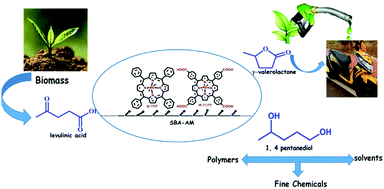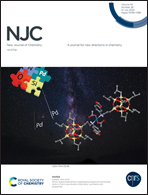Rhodium porphyrin molecule-based catalysts for the hydrogenation of biomass derived levulinic acid to biofuel additive γ-valerolactone†
Abstract
Rhodium-meso-tetraphenylporphyrin (RhTPP) and rhodium-meso-tetrakis(4-carboxyphenyl)porphyrin (RhTCPP) complexes were synthesized and surface grafted on amine-functional mesoporous molecular sieves. The formation of ligands (TPP and TCPP) and their rhodium complexes (RhTPP and RhTCPP) was evident with the help of 1H NMR, 13C NMR, mass spectral and elemental (CHN) analysis. The absence of the pyrrole proton of the porphyrin units on RhTPP and RhTCPP confirmed the successful formation of metallo-macro-molecules. Further, RhTPP and RhTCPP were fixed on the surface of SBA-15 through amino-silane as the linker. The rhodium containing homogeneous (RhTPP and RhTCPP) and heterogeneous catalysts (RhTPP-SBA-AM and RhTCPP-SBA-AM) were used for biomass-derived levulinic acid hydrogenation. Further, the synthesized catalysts were utilized for the hydrogenation of various organic molecules having arene, carbonyl, and alkene functionality under moderate reaction conditions. Both homogeneous and heterogeneous catalysts showed more than 95% levulinic acid conversion even after four cycles. The homogeneous RhTPP and RhTCPP yielded γ-valerolactone (GVL) as a major product, whereas heterogeneous catalysts showed only comparable γ-valerolactone (GVL) selectivity, with improved reusability and recylability in the presence of relatively lower amounts of rhodium complexes. Among RhTPP and RhTCPP, RhTPP showed better selectivity for γ-valerolactone (GVL) compared to RhTCPP. Further, as the number of catalytic runs increased, there was a gradual increase in diol selectivity, which was predominant in the case of RhTCPP, possibly due to the presence of the hydrophilic carboxylate ion which facilitates the interaction of water by-products with γ-valerolactone and favours diol formation. The hydrophobic environment of the RhTPP catalyst facilitated the formation of γ-valerolactone as the major product even in the fifth run.



 Please wait while we load your content...
Please wait while we load your content...